Vimar R14546 Handleiding
Vimar
Niet gecategoriseerd
R14546
Bekijk gratis de handleiding van Vimar R14546 (6 pagina’s), behorend tot de categorie Niet gecategoriseerd. Deze gids werd als nuttig beoordeeld door 66 mensen en kreeg gemiddeld 4.8 sterren uit 33.5 reviews. Heb je een vraag over Vimar R14546 of wil je andere gebruikers van dit product iets vragen? Stel een vraag
Pagina 1/6

Viale Vicenza, 14
36063 Marostica VI - Italy
www.vimar.com
49400480A0 04 1806
Eikon
20546
Arké
19546
Idea
16986
Plana
14546
Apparecchio di comando a tre pulsanti basculanti e attuatore con
uscita a relè in scambio 8 A, da completare con tasti intercambiabili 1
o 2 moduli - 3 moduli.
Dispositivo da utilizzare come tre pulsanti singoli oppure uno singolo e uno doppio a seconda del tasto
considerato; i pulsanti possono essere configurati anche indipendentemente dal relè. Il pulsante può
essere premuto sia nella parte superiore che inferiore. Il relè può essere configurato per funzionare sia in
modalità monostabile che bistabile.
CARATTERISTICHE.
• Tensione nominale di alimentazione: BUS 29 V
• Assorbimento: 16 mA
• Uscita a relè in scambio
• Carichi comandabili a 120 - 230 V~ (contatto NO):
- carichi resistivi: 8 A (20.000 cicli)
- lampade a incandescenza: 8 A (20.000 cicli)
- lampade fluorescenti e lampade a risparmio energetico: 1 A (20.000 cicli)
- trasformatori elettronici: 4 A (20.000 cicli)
- trasformatori ferromagnetici: 8 A (20.000 cicli)
• Carichi comandabili a 120 - 230 V~ (contatti NC e NO):
- motori cos ø 0,6: 3,5 A (100.000 cicli)
• Tasto: 1 doppio e 1 singolo oppure 3 singoli
• Morsetti: bus TP, contatti relè (NO, C, NC)
• Funzioni realizzabili:
- interruttore ON/OFF
- comando per tapparelle
- comando per regolatore
- attivazione di 2 scenari
• Compatibile con centrali By-me 8 moduli incasso e parete ver. 2.0 e successive e centrali
By-me 2 moduli ver. 2.0 e successive
CONFIGURAZIONE.
PER LE OPERAZIONI DI INSTALLAZIONE E CONFIGURAZIONE, VEDERE IL MANUALE
ISTRUZIONI DEL SISTEMA By-me ALLEGATO ALLA CENTRALE DI CONTROLLO.
L’operazione di configurazione deve essere effettuata con il dispositivo privo di tasto per poter premere
il pulsante di configurazione. Il dispositivo può essere utilizzato come tre pulsanti singoli oppure un
pulsante doppio e uno singolo.
• Blocchi funzionali: 4 (3 pulsanti, 1 relè), ogni blocco funzionale può appartenere al massimo a 4 gruppi.
• Selezione del blocco funzionale (configurazione): durante la creazione dei gruppi, quando la centrale
richiede di premere il pulsante dei dispositivi:
- premere il pulsante di configurazione;
- se il dispositivo deve essere configurato come tre pulsanti singoli premere, entro 3 s, il pulsante
destro per selezionare il blocco funzionale destro, il pulsante centrale per selezionare il blocco funzio-
nale al centro e il pulsante sinistro per selezionare il blocco funzionale sinistro; il led rosso si accende.
Se non viene premuto nessuno dei due tasti, entro 3 s circa il led rosso si accende; in questo caso
il blocco funzionale selezionato è il quarto, quello relativo all’attuatore.
- se il dispositivo deve essere configurato come un pulsante doppio e uno singolo, si effettua:
• la configurazione del blocco funzionale sinistro nel caso in cui si desideri ottenere un pulsante
da due moduli nella parte sinistra del dispostivo (tasto sinistro + tasto centrale) e poi si configura il
blocco funzionale destro (tasto destro);
• la configurazione del blocco funzionale centrale nel caso in cui si desideri ottenere un pulsante
da due moduli nella parte destra del dispostivo (tasto centrale + tasto destro) e quindi si configura il
blocco funzionale sinistro (tasto sinistro).
- il led rosso si accende e la centrale configura il blocco funzionale; al termine dell’operazione il led rosso si spegne.
A dispositivo non configurato l’attuatore è comandato dal pulsante sinistro.
PARAMETRI.
• Per i blocchi funzionali relativi ai tre pulsanti è possibile impostare la modalità di funzionamento:
- pulsante ON/OFF;
- pulsante controllo regolatore;
- pulsante controllo tapparelle;
- comando scenario.
• Funzionamento come pulsante controllo regolatore:
- premendo il tasto sopra per meno di 0,5 s il carico si accende si accende regolato al punto memorizzato;
- premendo il tasto sopra per più di 0,5 s la luminosità aumenta fino al rilascio;
- premendo il tasto sotto per più di 0,5 s la luminosità decresce fino al rilascio;
- premendo il tasto sotto per meno di 0,5 s il carico si spegne.
• Funzionamento come pulsante per controllo tapparelle:
- premendo il tasto sopra per più di 0,5 s la tapparella si apre completamente; l’arresto avviene ad
apertura completata oppure per pressione breve (sia sopra che sotto);
- premendo il tasto sotto per più di 0,5 s la tapparella si chiude completamente; l’arresto avviene a
chiusura completata oppure per pressione breve (sia sopra che sotto).
• Parametri led:
- led disabilitato;
- led con funzionamento normale (acceso se l’attuatore associato è in ON);
- led con funzionamento invertito;
- led sempre acceso per individuazione al buio;
- led centrale con funzionamento normale (tasto doppio);
- led centrale con funzionamento invertito (tasto doppio);
- led centrale sempre acceso per individuazione al buio (tasto doppio).
Nel caso il blocco funzionale appartenga a più di un gruppo, i parametri “led con funzionamento
normale” e “led con funzionamento invertito” non sono disponibili. In questi casi il comando è confer-
mato da un cambio di stato del led per 3 s. Nel caso si utilizzi un tasto doppio, è necessario settare il
comportamento del led centrale per renderne visibile lo stato. In questo caso configurare il pulsante
sinistro se il tasto doppio si trova nella parte sinistra del dispositivo oppure il pulsante centrale se il
tasto doppio si trova nella parte destra.
• Blocco funzionale 4, relativo al relè (vedere figura 1):
- funzionamento monostabile o bistabile;
- ritardo attivazione e ritardo disattivazione: un valore compreso tra 0 e 200 esprime un tempo in
secondi, un valore compreso tra 201 e 250 esprime un tempo in minuti (per esempio 201 = 1
minuto, 202 = 2 minuti, ecc.).
.Funzionamento monostabile
Ritardo di attivazione: ritardo nella chiusura del contatto NO del relè dalla ricezione del comando di
chiusura. Ritardo di disattivazione: tempo di permanenza del relè con il contatto NO chiuso.
.Funzionamento bistabile
Ritardo di attivazione: ritardo nella chiusura del contatto NO del relè dalla ricezione del comando di ON.
Ritardo di disattivazione: ritardo nell’apertura del contatto NO del relè dalla ricezione del comando di OFF.
Nel caso si crei un gruppo con più relè in modalità monostabile, impostare per tutti gli stessi ritardi
di attivazione e disattivazione e non inserire altri tipi di attuatori all’interno dello stesso gruppo; in
questo modo è possibile avere l’indicazione dello stato del relè monostabile sul tasto di comando.
Per esigenze particolari è possibile utilizzare la profondità di gruppo (per esempio per attivare con
un unico pulsante regolatori o relè bistabili).
• Parametri di default: i tre tasti sono abilitati come controllo regolatore e led in funzionamento norma-
le; relè impostato in funzionamento bistabile con ritardo di attivazione e disattivazione nullo. I tasti
sono impostati come pulsanti ON/OFF.
SCENARI.
Ogni pulsante basculante può essere dedicato all’attivazione di uno o due scenari. L’attuatore può
appartenere a più scenari diversi e, per ognuno di essi, memorizzare lo stato da richiamare all’attiva-
zione dello scenario stesso. Per ulteriori dettagli si veda il manuale della centrale di controllo.
REGOLE DI INSTALLAZIONE.
L’installazione deve essere effettuata da personale qualificato con l’osservanza delle disposizioni regolanti
l’installazione del materiale elettrico in vigore nel paese dove i prodotti sono installati. Il circuito di alimenta-
zione dell’uscita a relè deve essere protetto contro i sovraccarichi da un dispositivo, fusibile o interruttore
automatico, con corrente nominale non superiore a 10 A. Per ulteriori istruzioni si faccia riferimento al
manuale in allegato alla centrale di controllo.
CONFORMITÀ NORMATIVA.
Direttiva BT. Direttiva EMC. Norma EN 50428.
Rita ord
attivazione
Ritardo disattivazione
Comando
ON
Rita ord
attivazione
Comando
ON
Rita ord
disattivazione
Comando
OFF
ATT IVAZIONE DISATTIVAZIONE
MONOSTABILE
BISTABILE
FIGURA 1.
VISTA FRONTALE.
Pulsante di configurazione
VISTA POSTERIORE.
120-230
Morsetti bus TP
NO
C
NC
Led
RAEE - Informazione agli utilizzatori
Il simbolo del cassonetto barrato riportato sull’apparecchiatura o sulla sua confezione indica che il
prodotto alla fine della propria vita utile deve essere raccolto separatamente dagli altri rifiuti. L’utente
dovrà, pertanto, conferire l’apparecchiatura giunta a fine vita agli idonei centri comunali di raccolta dif-
ferenziata dei rifiuti elettrotecnici ed elettronici. In alternativa alla gestione autonoma, è possibile con-
segnare gratuitamente l’apparecchiatura che si desidera smaltire al distributore, al momento dell’ac-
quisto di una nuova apparecchiatura di tipo equivalente. Presso i distributori di prodotti elettronici con
superficie di vendita di almeno 400 m 2 è inoltre possibile consegnare gratuitamente, senza obbligo
di acquisto, i prodotti elettronici da smaltire con dimensioni inferiori a 25 cm. L’adeguata raccolta
differenziata per l’avvio successivo dell’apparecchiatura dismessa al riciclaggio, al trattamento e allo
smaltimento ambientalmente compatibile contribuisce ad evitare possibili effetti negativi sull’ambien-
te e sulla salute e favorisce il reimpiego e/o riciclo dei materiali di cui è composta l’apparecchiatura.

Viale Vicenza, 14
36063 Marostica VI - Italy
www.vimar.com
49400480A0 04 1806
Eikon
20546
Arké
19546
Idea
16986
Plana
14546
Three rocker push buttons and actuator with 8 A change-over relay output,
to complete with interchangeable 1 or 2-module buttons – 3 modules.
Device to be used as three single buttons or one single and one double, depending on the button. It can
be pressed both at the top and at the bottom. The relay can be configured to work in both one-position
and two-position stable mode.
CHARACTERISTICS.
• Rated supply voltage: BUS 9 V
• Input: 16 mA
• Changeover relay output
• Controllable loads at 120-230 V~ (contact NO):
- resistive loads: 8 A (20.000 cycles)
- incandescent lamps: 8 A (20.000 cycles)
- fluorescent lamps and energy saving lamps: 1 A (20.000 cycles)
- electronic transformers: 4 A (20.000 cycles)
- ferromagnetic transformers: 8 A (20.000 cycles)
• Controllable loads at 120-230 V~ (contacts NC and NO):
- motors cos ø 0.6: 3,5 A (100.000 cycles)
• Button: 1 double, 1 single or 3 single ones.
• Terminals: TP bus, relay contacts (NO, C, NC)
• Possible functions:
- ON/OFF switch
- roller shutter control
- dimmer control
- activation of 2 scenarios.
• Consist with:
- By-me flush and surface mounting control units, rel.2.0 and next
- By-me 2-module control units, rel. 2.0 and next
CONFIGURATION.
FOR THE OPERATIONS OF INSTALLATION AND CONFIGURATION, SEE THE By-me SYSTEM
INSTRUCTIONS MANUAL ATTACHED TO THE CONTROL UNIT.
Configuration must be done with the device without the key to be able to press the central configuration
button.
The device can be used as three single buttons or one double push-button and a single one.
• Functional blocks: 4 (3 buttons, 1 relay), each functional block can belong to at most 4 groups.
• Selecting the functional block (configuration): during group creation, when the control unit requires pressing
the device button:
- press the configuration button;
- if the device must be configured as three single push-buttons, within 3 s, press the right-hand button
to select the right functional unit, the middle button to select the middle functional unit or the left-hand
button to select the left functional unit; the red LED illuminates. If none of the three buttons is pressed
within approximately 3 s the red LED will light up; in this case the functional block selected is the 4th,
referring to the actuator.
- if the device must be configured used as a double and a single push-button, proceed as follows:
• configure the left functional unit in the case in which you want a push-button with two modules on the left of
the device (left button + middle button) and then configure the right functional unit (right button);
• configure the middle functional unit in the case in which you want a push-button with two modules on the
right of the device (middle button + right button) and then configure the left functional unit (left button).
- with the red LED on, the control unit will configure the functional block; at the end of this operation the red
LED will go out.
When the device is not configured, the actuator is controlled by the left-hand button.
PARAMETERS.
• For the functional blocks related to the tree buttons it is possible to set the operating mode:
- ON/OFF button;
- dimmer control button;
- roller shutter control button;
- scenario control.
• Operation as a dimmer control button:
- pressing the key above for less than 0.5 s lights up the load with the dimming at the saved point;
- pressing the key above for more than 0.5 s increases brightness until it is released;
- pressing the key below for more than 0.5 s decreases brightness until it is released;
- pressing the key below for less than 0.5 s switches off the load.
• Operation as a roller shutter control button:
- pressing the key above for more than 0.5 s opens the shutter completely; it stops when fully open or
when briefly pressing the key (either above or below);
- pressing the key below for more than 0.5 s closes the shutter completely; it stops when fully closed or
when briefly pressing the key (either above or below);
• LED parameters:
- LED off;
- LED with normal operation (on if the associated actuator is ON);
- LED with reverse operation;
- LED always on for location in the dark;
- central LED with normal operation (Double button);
- central LED with reverse operation (Double button);
- central LED always on for location in the dark (Double button).
If the functional block belongs to more than one group, the “LED with normal operation” and “LED
with reverse operation” parameters are not available. In these cases the control is confirmed by a LED
status change for 3 s. If a double key is used, it is necessary to set the central LED behaviour to make
the status visible. In this case, configure the left button if the double button is on the left of the device
or the middle button if the double button is on the right.
• Functional block 4, related to the relay (see figure 1):
- one- or two-position stable operation;
- on delay and off delay: a value between 0 and 200 gives the time in seconds, a value between 201
and 250 gives the time in minutes (for example 201 = 1 minute, 202 = 2 minutes, etc.);
.One-position stable operation
On delay: delay in closing the NO contact of the relay from receiving the close command. Off delay:
time for which the relay has the NO contact closed.
Two-position stable operation.
On delay: delay in closing the NO contact of the relay from receiving the ON command. Off delay: delay in
opening the NO contact of the relay from receiving the OFF command.
If a group is created with a number of relays in one-position stable mode, set for all the same on and
off delays and do not insert any other types of actuator in the same group; in this way, it is possible to
have the status of the one-position stable relay indicated on the control button. For special require-
ments it is possible to use the group depth (for example to switch on two-position stable relays or
dimmers with a single button).
• Default parameters: the two keys are enabled as a dimmer control and LED in normal operation;
relay set on two-position stable operation with null on and off delay. the buttons are set as ON/
OFF push-buttons (step step) and LED in normal operation. The buttons are set as ON/OFF push-
buttons (step step).
SCENARIOS.
Each tilt button can be dedicated to activating one or two scenarios. The actuator can belong to
multiple scenarios and, for each one of them, save the status to retrieve when activating the scenario.
For further details see the control panel manual.
INSTALLATION RULES.
Installation should be carried out by qualified staff in compliance with the current regulations regarding
the installation of electrical equipment in the country where the products are installed. The feeding
circuit of the relay output must be protected against overloads by a device, fuse or automatic circuit
breaker, with rated current not higher than 10 A. For further instructions, please see the manual attached
to the control panel.
CONFORMITY.
LV directive. EMC directive. Standard EN 50428.
ON delay
ON delay
Cont lro
ON
ON delay
Cont lro
ON
OFF delay
Cont lro
OFF
ON OFF
MONOSTABLE
BISTABLE
FIGURE 1.
FRONT VIEW.
BACK VIEW.
Terminals bus TP
Configuration button
120-230
NO
C
NC
Led
WEEE - Information for users
If the crossed-out bin symbol appears on the equipment or packaging, this means the product
must not be included with other general waste at the end of its working life. The user must take
the worn product to a sorted waste center, or return it to the retailer when purchasing a new one.
Products for disposal can be consigned free of charge (without any new purchase obligation) to
retailers with a sales area of at least 400 m2, if they measure less than 25 cm. An efficient sorted
waste collection for the environmentally friendly disposal of the used device, or its subsequent
recycling, helps avoid the potential negative effects on the environment and people’s health, and
encourages the re-use and/or recycling of the construction materials.

Viale Vicenza, 14
36063 Marostica VI - Italy
www.vimar.com
49400480A0 04 1806
Eikon
20546
Arké
19546
Idea
16986
Plana
14546
Trois poussoirs basculants et actuateur avec sortie à relais inverseur 8 A, à
compléter avec touches interchangeables 1 ou 2 modules - 3 modules.
Dispositif à utiliser en tant que 3 boutons simples ou un simple et un double selon le bouton considéré.. Les
poussoirs peuvent être configurés également indépendamment du relais. Il peut être appuyé dans la
partie
supérieure et inférieure. Le relais peut être configuré pour fonctionner tant en mode monostable que bistable.
CARACTÉRISTIQUES.
• Tension nominale d’alimentation : BUS 29 V
• Absorption : 16 mA
• Sortie à relais inverseur
• Charges commandables à 120-230 V~ (contact NO):
- charges résistives: 8 A (20.000 cycles)
- lampes à incandescence : 8 A (20.000 cycles)
- lampes fluorescentes et lampes à économie d’énergie : 1 A (20.000 cycles)
- transformateurs électroniques 4 A (20.000 cycles)
- transformateurs ferromagnétiques : 8 A (20.000 cycles)
• Charges commandables à 120-230 V~ (contacts NC et NO):
- moteurs cos ø 0,6 : 3,5 A (100.000 cycles)
• Touche : 1 double, 1 simple ou 3 simples
• Bornes : bus TP, contacts relais (NO, C, NC)
• Fonctions réalisables :
- interrupteur ON/OFF
- commande pour stores
- commande pour variateur
- activation de 2 situations.
• Compatible avec centrales By-me 8 modules d’encastrement et pour pose en saillie, vers. 2.0 et
suivantes et centrales By-me 2 modules, vers. 2.0 y suivantes.
CONFIGURATION.
POUR LES OPÉRATIONS D’INSTALLATION ET DE CONFIGURATION, VOIR LE MANUEL
D’INSTRUCTIONS DU SYSTÈME By-me ANNEXÉ À LA CENTRALE DE CONTRÔLE.
L’opération de configuration doit être effectuée avec le dispositif exempt de touche pour pouvoir appuyer
sur le bouton central de configuration. Le dispositif peut être utilisé en tant que 3 boutons simples ou un
bouton double et un simple.
• Blocs fonctionnels : 4 (3 boutons, 1 relais) ; chaque bloc fonctionnel peut appartenir au maximum à 4 groupes.
• Sélection du bloc fonctionnel (configuration) : durant la création des groupes, lorsque la centrale demande
d’appuyer sur le bouton des dispositifs :
- appuyer sur le bouton de configuration ;
- si le dispositif doit être configuré comme 3 boutons simples appuyer dans les 3 sec. le bouton droite pour
sélectionner le bloc fonctions droit, le bouton central pour sélectionner le bloc fonctions central et le bouton
gauche pour sélectionner le bloc fonctions gauche; la led rouge s’allume. Si aucune des 3touches n’est
appuyée dans les 3 s environ, la led rouge s’allume ; dans ce cas, le bloc fonctionnel choisi est le quatrième,
concernant l’actuateur.
- si le dispositif doit être configuré comme un bouton double et un simple, on effectue :
• la configuration du bloc fonctions gauche pour obtenir un bouton 2 modules à gauche du dispositif (touche
gauche + touche centrale) et on configure le bloc fonctions droit (touche droite);
• la configuration du bloc fonctions central pour obtenir un bouton 2 modules à droite du dispositif (touche
centrale + touche droite) et pour configurer le bloc fonctions gauche (touche gauche).
-
lorsque la led rouge est allumée, la centrale configure le bloc fonctionnel ; à la fin de l’opération, la led rouge s’éteint.
A dispositif non configuré, l’actuateur est commandé par le bouton de gauche.
PARAMÈTRES.
•
Pour les blocs fonctionnels relatifs aux boutons, il est possible d’introduire le mode de fonctionnement :
- bouton ON/OFF ;
- bouton contrôle variateur ;
- bouton contrôle stores ;
- commande situation.
• Fonctionnement comme bouton contrôle variateur :
- en appuyant sur la touche dans la partie supérieure pendant moins de 0,5 s, la charge s’allume réglée
au point mémorisé ;
- en appuyant sur la touche dans la partie supérieure pendant plus de 0,5 s, la luminosité augmente
jusqu’au relâchement ;
- en appuyant sur la touche dans la partie inférieure pendant plus de 0,5 s, la luminosité diminue jusqu’au
relâchement ;
- en appuyant sur la touche dans la partie inférieure pendant moins de 0,5 s, la charge s’éteint.
• Fonctionnement comme bouton pour contrôle stores :
- en appuyant sur la touche dans la partie supérieure pendant plus de 0,5 s, le store s’ouvre complète-
ment ; l’arrêt a lieu à ouverture complétée ou bien par pression brève (tant dans la partie supérieure que
dans la partie inférieure) ;
- en appuyant sur la touche dans la partie inférieure pendant plus de 0,5 s, le store se ferme complète-
ment ; l’arrêt a lieu à fermeture complétée ou bien par pression brève (tant dans la partie supérieure que
dans la partie inférieure) ;
• Paramètres led :
- led invalidée ;
- led avec fonctionnement normal (allumée si l’actuateur associé est sur ON) ;
- led avec fonctionnement inversé ;
- led toujours allumée pour individualisation dans le noir ;
- led centrale avec fonctionnement normal (Double button) ;
- led centrale avec fonctionnement inversé (Double button);
- led centrale toujours allumée pour individualisation dans le noir (Double button).
Lorsque le bloc fonctionnel appartient à plus d’un groupe, les paramètres “led avec fonctionnement
normal” et “led avec fonctionnement inversé” ne sont pas disponibles. Dans ces cas, la commande est
confirmée par un changement d’état de la led pendant 3 s. Si l’on utilise une touche double, il est néces-
saire de définir le comportement de la led centrale pour en rendre l’état visible. Dans ce cas configurer
le bouton gauche si la touche double se trouve dans la partie gauche du dispositif ou le bouton central
si la touche double se trouve dans la partie droite.
• Bloc fonctionnel 4, relatif au relais (voir figure 1) :
- fonctionnement monostable ou bistable ;
- retard activation et retard désactivation : une valeur comprise entre 0 et 200 exprime un temps en
secondes, une valeur comprise entre 201 et 250 exprime un temps en minutes (par exemple 201 = 1
minute, 202 = 2 minutes, etc.) ;
.Fonctionnement monostable
Retard d’activation : retard dans la fermeture du contact NO du relais depuis la réception de la
commande de fermeture. Retard de désactivation : temps de permanence du relais avec le contact
NO fermé.
.Fonctionnement bistable
Retard d’activation : retard dans la fermeture du contact NO du relais depuis la réception de la commande
de ON. Retard de désactivation : retard dans l’ouverture du contact NO du relais depuis la réception de la
commande de OFF.
Lorsque l’on crée un groupe avec plusieurs relais en modalité monostable, introduire pour tous les
mêmes retards d’activation et de désactivation et ne pas insérer d’autres types d’actuateurs à l’intérieur
du même groupe ; de cette manière, il est possible d’avoir l’indication de l’état du relais monostable
sur la touche de commande. Pour des exigences particulières, il est possible d’utiliser la profondeur de
groupe (par exemple, pour activer avec un seul bouton variateurs ou relais bistables).
•
Paramètres par défaut : les deux touches sont validées comme contrôle variateur et led en fonction-
nement normal ; relais défini en fonctionnement bistable avec retard d’activation et désactivation nul.
Les touches sont configurées comme boutons ON/OFF (par pas).
SCENARIOS.
Chaque poussoir basculant peut être dédié à l’activation d’une ou deux scénarios. L’actionneur peut
appartenir à plusieurs scénarios différents et, pour chacun d’eux, mémoriser l’état à rappeler lors de
l’activation du scénario. Pour tout détail technique voir le manuel d’instructions du module centrale
de contrôle.
RÈGLES D’INSTALLATION.
L’installation doit être confiée à un technicien qualifié et exécutée conformément aux dispositions qui
régissent l’installation du matériel électrique en vigueur dans le pays concerné. Le circuit d’alimentation
de la sortie à relais doit être protégé contre les surcharges par un dispositif, un fusible ou un interrupteur
automatique, avec courant nominal ne dépassant pas 16 A. Pour de plus amples instructions, voir le
manuel annexé à la centrale de contrôle.
CONFORMITÉ AUX NORMES.
Directive BT. Directive EMC. Norme EN 50428
Retard
d’activation
Retard de désactivation
Commande
ON
Retard
d’activation
Commande
ON
Retard de
désactivation
Commande
OFF
ACTI TION DÉSACTI TIONVA VA
MONOSTABLE
BISTABLE
FIGURE 1.
VUE FRONTALE.
Bouton de configuration
VUE ARRIÈRE.
Bornes bus TP
120-230
NO
C
NC
Led
DEEE - Informations pour les utilisateurs
Le symbole du caisson barré, là où il est reporté sur l’appareil ou l’emballage, indique que le
produit en fin de vie doit être collecté séparément des autres déchets. Au terme de la durée de
vie du produit, l’utilisateur devra se charger de le remettre à un centre de collecte séparée ou bien
au revendeur lors de l’achat d’un nouveau produit. Il est possible de remettre gratuitement, sans
obligation d’achat, les produits à éliminer de dimensions inférieures à 25 cm aux revendeurs dont la
surface de vente est d’au moins 400 m 2
. La collecte séparée appropriée pour l’envoi successif de
l’appareil en fin de vie au recyclage, au traitement et à l’élimination dans le respect de l’environne-
ment contribue à éviter les effets négatifs sur l’environnement et sur la santé et favorise le réemploi
et/ou le recyclage des matériaux dont l’appareil est composé.
Product specificaties
| Merk: | Vimar |
| Categorie: | Niet gecategoriseerd |
| Model: | R14546 |
Heb je hulp nodig?
Als je hulp nodig hebt met Vimar R14546 stel dan hieronder een vraag en andere gebruikers zullen je antwoorden
Handleiding Niet gecategoriseerd Vimar
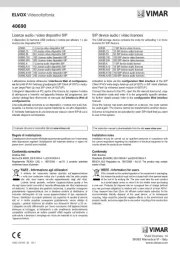
2 September 2025
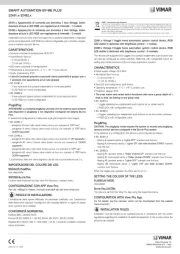
26 Augustus 2025
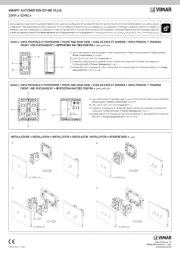
26 Augustus 2025
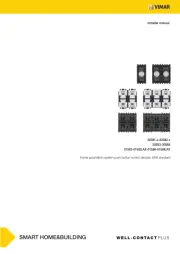
26 Augustus 2025
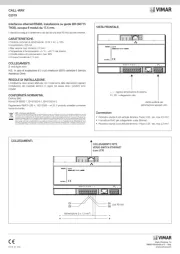
14 Augustus 2025
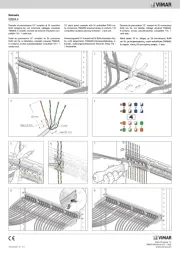
5 Juli 2025
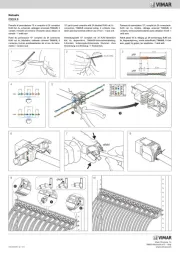
5 Juli 2025
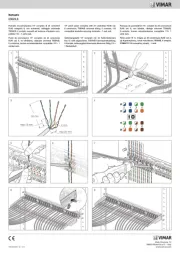
5 Juli 2025

5 Juli 2025
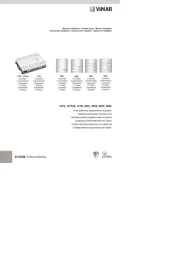
24 Mei 2025
Handleiding Niet gecategoriseerd
- Synology
- Chef's Choice
- P3 International
- Multibrackets
- Beretta
- Uvex
- Ankarsrum
- ATP
- Vicks
- Senseca
- Tempmate
- Sanli
- TC Helicon
- Favero
- Das Keyboard
Nieuwste handleidingen voor Niet gecategoriseerd

14 September 2025

14 September 2025

13 September 2025

13 September 2025

13 September 2025

13 September 2025

13 September 2025

13 September 2025

13 September 2025

13 September 2025